
The Agelenidae are a large family of spiders in the suborder Araneomorphae. Well-known examples include the common "grass spiders" of the genus Agelenopsis. Nearly all Agelenidae are harmless to humans, but the bite of the hobo spider may be medically significant, and some evidence suggests it might cause necrotic lesions, but the matter remains subject to debate. The most widely accepted common name for members of the family is funnel weaver.
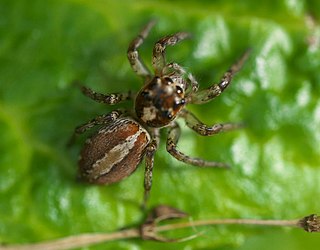
Plexippoides is a genus of jumping spiders that was first described by Jerzy Prószyński in 1984. The name means "having the likeness of Plexippus"
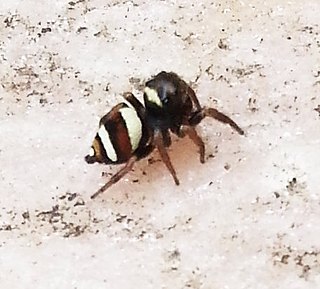
Ptocasius is a genus of Asian jumping spiders that was first described by Eugène Louis Simon in 1885.

Synagelides is a genus of Asian jumping spiders that was first described by W. Bösenberg & Embrik Strand in 1906. This genus and Agorius are separated as a genus group, sometimes called subfamily Agoriinae, but more recently downranked to tribe Agoriini of the Salticoida clade in subfamily Salticinae.
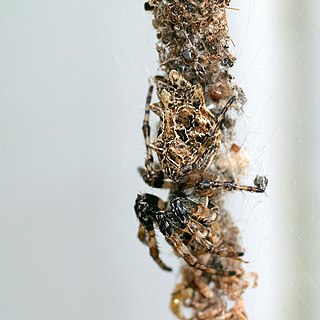
Cyclosa, also called trashline orbweavers, is a genus of orb-weaver spiders first described by Anton Menge in 1866. Widely distributed worldwide, spiders of the genus Cyclosa build relatively small orb webs with a web decoration. The web decoration in Cyclosa spiders is often linear and includes prey remains and other debris, which probably serve to camouflage the spider. The name "Cyclosa" comes from Greek 'to move in a circle', referring to how it spins its web.

Clubiona is a genus of sac spiders that was first described by Pierre André Latreille in 1804.

Macrothele is a genus of mygalomorph spiders in the family Macrothelidae, and was first described by A. Ausserer in 1871. Most species occur in Asia, from India to Japan, and Java, with five found in Africa, and two in Europe. The name is derived from Ancient Greek μακρός ("makro-"), meaning "big", and θηλή ("thele"), referring to the spinnerets.
Sinocyclocheilus is a genus of freshwater fish in the family Cyprinidae that is endemic to Guangxi, Guizhou and Yunnan in China. Almost all of its species live in or around caves and most of these have adaptions typical of cavefish such as a lack of scales, lack of pigmentation and reduced eyes. Several species have an unusual hunchbacked appearance and some of the cave-dwellers have a "horn" on the back, the function of which is unclear. In contrast, the Sinocyclocheilus species that live aboveground, as well as a few found underground, show no clear cavefish adaptions. They are relatively small fish reaching up to 23 cm (9.1 in) in length. The individual species have small ranges and populations, leading to the status of most of the evaluated species as threatened. Many species populations in the genus have yet to be evaluated by the IUCN.

Triplophysa is a genus of fish in the family Nemacheilidae found mainly in and around the Qinghai-Tibet Plateau in China, as well as inland waters of the larger part of central Asia. They can be distinguished from other genera of Nemacheilidae by marked sexual dimorphism, including the development of nuptial tubercles on breeding males. Currently, the genus is a mixed assemblage of species. Some lineages have been identified and treated as subgenera, but as Wikipedia follows Fishbase for fish species all but Hedinichthys have been treated as subgenera in Wikipedia, although Kottelat in his revision of the loaches did recognise them as valid. FishBase, however, includes these in Triplophysa without specifying subgenera and treats the names given by Kottelat as synonyms.

Pireneitega is a genus of funnel weavers first described by Kyukichi Kishida in 1955.

Sinopoda is a genus of Asian huntsman spiders that was first described by Peter Jäger in 1999.
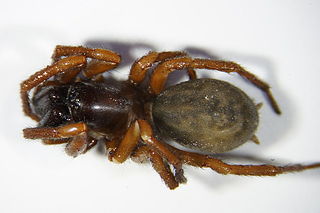
Coelotes is a genus of funnel weavers first described by John Blackwall in 1841. A large number of species are found throughout Europe and Asia.
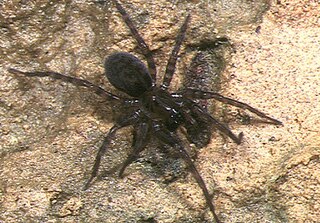
Iwogumoa is a genus of Asian funnel weavers first described by Kyukichi Kishida in 1955.
Leptonetela is a genus of leptonetids that was first described by J. Kratochvíl in 1978.

Eriovixia is a genus of orb-weaver spiders first described by Allan Frost Archer in 1951.
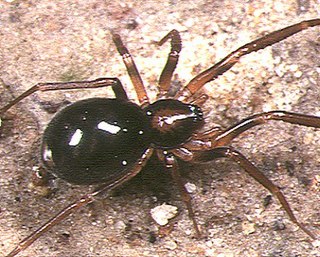
Otacilia is a genus of araneomorph spiders in the family Phrurolithidae, first described by Tamerlan Thorell in 1897.
Draconarius is a genus of Asian funnel weavers first described by S. V. Ovtchinnikov in 1999.
The human identical sequence (HIS) is a sequence of RNA elements, 24-27 nucleotides in length, that coronavirus genomes share with the human genome. In pathogenic progression, HIS acts as a NamiRNA (nuclear activating miRNA) through the NamiRNA-enhancer network to activate neighboring host genes. The first HIS elements was identified in the SARS-CoV-2 genome, which has five HIS elements; other human coronaviruses have one to five. It has been suggested that these sequences can be more generally termed "host identical sequences" since similar correlations have been found between the genome of SARS-CoV-2 and multiple potential hosts (bats, pangolins, ferrets, and cats).
Grandilithus is a genus of araneomorph spiders in the family Phrurolithidae. It was first described by Liu & Li in 2022.













